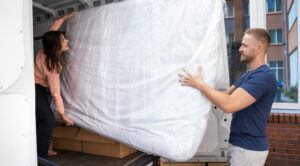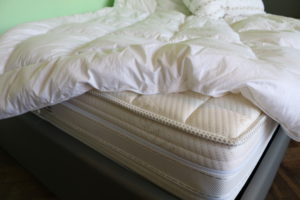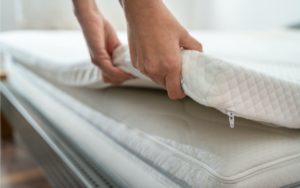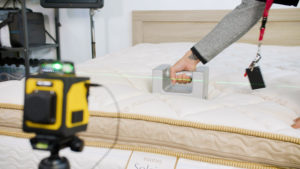How to Dispose of a Mattress
While trying to find the best mattress for you can be frustrating, every mattress owner inevitably reaches the point where it’s clear that it’s time to level up. Some people decide to switch out their mattress because they’re interested in a new model or mattress type, and some people seek out a new mattress because their comfort requirements have changed over time, because of factors like age, losing or gaining weight, and/or injuries. However, even someone who isn’t particularly interested in other mattresses will need to replace their mattress eventually.
There are a number of different ways to get rid of a used mattress, from recycling to donation to throwing it away. The method that’s right for you depends on a number of different factors, especially the state of the mattress, where you are located, and which facilities are close by offering which types of disposal and donation services.
We’ll break down the different methods of mattress disposal, how to choose the right one for you, and how to go about getting the disposal job done.
Let us help you find the perfect bed
Answer a few questions to find the right mattress for your unique needs
How Do I Know if I’m Ready For A New Mattress?
First things first: how do you know it’s time to get a new mattress?
The general consensus is that mattresses should be replaced, on average, every 8 years.
However, some types of mattresses tend to last longer than others. For instance, hybrid innerspring-foam mattresses tend to need replacing sooner, at around 6 years, while plain innerspring mattresses can last up to 10 years (and even longer if they’re double-sided). Meanwhile, memory foam and latex mattresses can last up to 15 years with the right care.
These figures are only the average lifespans of each type of mattress: some individual mattresses can last for less time than their mattress-type average, while some can last longer. The lifespan of a mattress can vary significantly, depending on factors like the design of the mattress, the materials it’s made of, how well you take care of it, and what sort of atmosphere it is exposed to in your bedroom.
The best and most accurate way to tell if your mattress needs to be replaced is how it feels, and what sort of rest you get when you sleep on it. Are you still getting the support and comfort from the mattress that you got from it in the past?
| Sagging | Wake up feeling tired or achy |
| Lumps | Have a hard time getting comfortable |
| Hammocking | Able to feel your partner’s movements more than you used to |
| Coils that can be felt through the top of the mattress | Increased difficulty falling or staying asleep |
| Noisy Springs | Sounds make wake you when you or your partner move around |
In addition, certain life changes may necessitate a change in mattress. For instance, if you move in with a partner, or add a medium-to-large pet (like a dog) to your nightly sleep routine, an older mattress may be more affected by the new distribution of weight, and may not be able to provide the same level of support.
Once you’ve decided it’s time for a new mattress, have shopped around and picked out your new model, and are all set to bring it home, there’s one final hurdle to face: what do you do with your old mattress?
Donating Your Mattress
Many people opt into donating their mattresses instead of disposing of them. This is a great opportunity to do something meaningful for people in need, while also making space for your new mattress.
However, it is very important to remember that not all mattresses are fit to be donated.
Though there are many reasons why people decide to buy a new mattress, some mattresses are discarded because they are very worn and/or no longer usable. These mattresses should not be donated.
Also, because of the influx of higher quality, more affordable beds, and because of regulatory and sanitation issues, standards have increased at charities and shelters when it comes to the suitability of mattresses for donation. Bringing in a sub-par mattress, beyond being rude, will generally be a waste of time for you and for the hardworking staff and volunteers at these organizations.
So How Do You Know If Your Mattress is in Good Enough Shape to be Donated?
Every charity, organization, and shelter has its own standards for what is acceptable for a donated mattress. However, there are a few standard guidelines:
- Infestations: Though this should go without saying, do not donate any mattresses with infestations of any kind, especially when it comes to bed bugs and mold. Even if you have cleaned your mattress on a surface level after finding bed bugs, mold, or other mattress-dwelling life forms, these infestations are often rooted deep in the mattress. You should consider any mattress you’re getting rid of after an infestation unsuitable for donation.
- Major Structural Problems: Issues like broken, jutting, or bending coils can make a mattress unusable. You will have noticed those issues the last time you slept on your mattress, and they are often visible from the outside. Structural problems that come from wear and tear, such as excessive sagging, irregular bunching, and large, permanent indentations may also make a mattress unsuitable to pass on to someone else.
- Rips, Tears, and Holes: Do not donate a mattress with large, obvious rips, tears, or holes. This includes seams that come undone and large gashes, but also small holes (like those from a dog bite or claw, or a cigarette burn). You should also make sure that the mattress cover is firmly attached before donating.
- Stains: Mattresses with stains should not be donated. This includes both large and small stains from any substance, as well as obvious, permanent discoloration from use over time. However, if you have a mattress with small spots, stains, or other issues you think a DIY cleaning could fix, you can use the following tricks to try to remove them and bring your mattress up to snuff for donation.
- Vacuum: This may sound crazy, but vacuuming the top and sides of a mattress can do wonders for removing pet hair and dander, human skin, and dust (as well as any other crumbs and bits that have found their way onto your mattress). It’s best to do this with a smaller or hand-held vacuum if you have one, but a regular vacuum will do the trick.
- Spot Clean: If you have a mattress with one or more small stains, you can try spot cleaning. There are a couple of ways to do this. You could use a non-toxic enzyme cleaner to chemically break down the stain. If you want to go more DIY, use a combination of hydrogen peroxide, liquid dish soap, and baking soda. Mix the combo into a spray bottle and apply to the stains, and then blot dry with a wet then dry clean rag. A third option is to combine lemon juice and salt until the mixture is thick and apply to the stain. Let it sit for around 45 minutes to an hour (depending on the size of the stain) and then wipe off with a clean rag.
Odors: Though people can sometimes be “noseblind” to odors in their own homes, a particularly strong odor on a mattress should be noticeable to you. When in doubt, call in a third party, preferably one who you do not live with, to do a sniff test. If you find that the mattress has a slight odor, you can try sprinkling a layer of baking soda on the surface and letting it sit for a few hours. Afterward, vacuum off the baking soda, and then, if possible, let the mattress air outside. If the odor remains, you should reconsider donating the mattress.
In general, figuring out if your mattress is up to donation standards is a matter of common sense.
Make sure the mattress is structurally sound, clean, and free of any infestations or odors. The mattress is not going to help anyone if it cannot be used. Think about whether or not you would want to receive your mattress as a donation. If not, then consider other options.
If you feel that your bed is in good shape for donation, then that’s great! You can move on to selecting the right place to donate.
Larger Organizations
These organizations are national or multinational, with establishments all across North America, and sometimes all across the world.
- Goodwill: Goodwill is a network of community-based nonprofits that sells donated items in thrift stores. These sales fund educational, training, and job placement programs for those with barriers to employment, such as people who have been downsized, people with disabilities, and people with limited work histories. Participants in Goodwill community programs are also often given vouchers for the Goodwill stores. There are 162 local Goodwills in the United States and Canada, and each location has its own policies on what they accept and if they offer home pick-up. A few locations accept mattresses in good condition, while others do not. Contact your local Goodwill to see if they are open to mattress donations.
- Habitat for Humanity: Habitat for Humanity is an organization that works worldwide to help people obtain affordable and sustainable housing, often by constructing new housing, or rehabilitating or preserving existing housing. Like Goodwill, they operate a chain of thrift stores called ReStore, whose sales go entirely to funding Habitat building and housing projects. Also like Goodwill, ReStore locations vary on what they can accept, and if they can offer home pick-up–especially when it comes to mattresses. Contact your closest ReStore location for their donation guidelines.
- Furniture Bank Association of America: The Furniture Bank Association of America, or FBA, is a network of furniture banks that provide furniture at low or no cost to underserved communities and people living in poverty. They have over 80 furniture banks across the U.S. and usually accept mattresses in good condition (ie, no structural problems, bed bugs, tears, or stains). Their general rule is that they will come and collect your acceptable-grade mattress if you live within 20 miles from one of their furniture banks–though some furniture banks locations may drive farther. If you can get the mattress to a furniture bank location yourself and it is in suitable condition, they should accept it, but make sure to call in advance. You can also check out their sister organization, Furniture Banks Across America, which provides a similar service.
- Catholic Charities: Catholic Charities operates smaller charitable service organizations all over the US, specifically helping children, refugees, people without homes, people with disabilities, and lower-income people. Their programs are for people of all (or no) religious affiliations, not just Catholics. They specifically run a number of residential housing programs and shelters, and in certain locations are often in need of beds in suitable donation condition (especially twin and full beds). Check their website to see if there are programs in need of mattresses near you. They will often also provide pick-up.
Local Donations
You may want to skip the larger organizations and go straight to the local level. In general, larger organizations tend to have stricter policies against accepting mattresses, for both regulatory and storage-space reasons. There are many ways to find local collectives, non-profits, and smaller organizations that will take your mattress and use it to help locally in your community.
If you’re not familiar with your local aid scene, one essential resource for finding the right place for your mattress is Donationtown.org. Donation Town is one of the best online resources for finding a place to donate your mattress to charity. They provide a completely free, searchable database of the charities in your area that might accept the mattress, with specifications about whether or not they provide donation pick-up services. If you’re looking to donate your mattress, check out Donation Town’s database to find a suitable charity.
You can also donate directly to a local shelter. A quick Google search should give you a list of contacts for your local shelters, including general population homeless shelters and shelters specifically for youth, women, and children. You can also search through an extensive database of shelters through United Way. Checking out a shelter’s website (or, more efficiently, calling them up) will let you know whether or not they are in need of your mattress.
Give It Away
If you can’t find an organization or charity to donate your mattress to, there’s always the option of giving it away to someone directly.
You can start by posting from your accounts on social media platforms and asking around to friends, family, and acquaintances in your network. People you may not have even thought of might be in need of a bed, or have use or space for a spare one.
You can also use localized social media platforms like Facebook Marketplace, NextDoor, and Freecycle, as well as any ListServe mailing lists you may be on, to advertise your mattress. Make sure to specify that it is totally free, and also to be clear about exactly what size it is, and what state it is in (so that you don’t wind up wasting both your time and the prospective new mattress owners’ time if it’s not the right fit.) Provide dimensions and pictures, if possible.
You also might want to consider placing flyers at local schools, coffee shops, community centers, or, if applicable, universities. Again, make sure to specify the size, state, and dimensions of the mattress.
Recycling Your Mattress
If you can’t find a suitable place to donate your mattress, or your mattress is no longer fit to sleep on, the next best thing is recycling. Close to 20 million mattresses wind up in landfills every year, with each mattress taking up to 40 cubic feet of space. This contributes significantly to landfill mass, which creates significant ecological and environmental problems, as well as unsafe conditions for workers around the world.
Around 80 to 90 percent of most mattresses can be broken down and recycled. However, recycling laws, regulations, and standards vary significantly by state, county, and even individual city and town ordinances.
In most places, however, there are two general ways to go about recycling your mattress.
Local Recycling Centers
Some recycling centers accept mattresses as-is. Though it may take some searching, many areas have at least one recycling facility in the general vicinity that will accept a whole mattress. Some facilities even contract with companies to pick up mattresses and recycle them for you for a small service charge (which usually doesn’t run more than $40.00). Certain states (specifically, Connecticut, Rhode Island, and California) have laws that make mattress recycling and pick-up free or very low-cost through Extended Producer Responsibility Programs (EPRs).
If you’re having trouble finding recycling facilities that will take a mattress, there are a few very helpful databases you can consult.
- Bye Bye Mattress: This database, run by the Mattress Recycling Council, is specific to EPR-enacted states (as mentioned above, Connecticut, Rhode Island, and California.) If you live in one of those states, check out this website for resources on how to find a minimal fee or free pick up a program to recycle your mattress.
- Earth 911: This organization’s website hosts one of North America’s most extensive recycling databases, with over 100,000 facility listings across the US and Canada. You can search specifically for facilities that accept mattresses closest to your zip code and can filter by factors like whether or not they charge a fee, or whether or not they offer pick-up. You can also access the database through their hotline, 1-800-CLEANUP.
- Municipal Offices: Many cities and towns have municipal offices that deal on a local level with trash and recycling. The specific department which handles those issues may be named different things in different places. Search for your specific city or town (or by your zip code) to see which municipal department is in charge of trash and recycling. It is possible that your specific town may not have a recycling program, but many towns and cities do. Call your local municipal office to get information on where and how to recycle a mattress.
- Local Residential Facilities: If you’re still having trouble finding a place to recycle your mattress, consider contacting local businesses, establishments, and facilities that house people overnight on a regular basis. This includes universities, hotels, and hospitals, among others. Because these facilities have a higher-than-average need for mattress disposal, many have relationships in place with local mattress disposal facilities and may be able to lead you in the direction of a recycling center that accepts mattresses.
DIY Recycling
In some cases, you may not be able to find a facility close enough to you that accepts whole mattresses, or you may not be able to transport a whole mattress to a facility that does not offer pick-up service. In that case, you’re not totally out of luck yet: there may still be recycling options!
- Break down the mattress and box spring yourself and recycle the parts. If you have the time, space, and tools, you can easily break down your mattress into recyclable parts, which some recycling centers that do not accept whole mattresses may accept instead. Make sure to call around to local recycling facilities to make sure they accept the materials before you show up or put your mattress materials out with your regular recycling. If your mattress has springs, you can also go to a local scrap metal dealership: many will actually pay you to take metal springs off your hands.
- Upcycle your mattress: If you’re a particularly crafty DIY-er, another option is to upcycle your mattress or parts of your mattress. This means re-using the mattress (or some of its materials) in various ways.
- Garden and Outdoors: Many parts of a mattress can be used in gardening. A wooden box spring can be broken down and used as compost or landscaping mulch, or it can be kept whole and used as a raised garden bed for veggies, herbs, or flowers.
- Home Repair: Mattress foam, fabric, and padding material can be used as padding, insulation, or even protective blankets for furniture during a move.
- Art projects and decor: There are many, many types of art pieces and unique home decor that can be made from parts of a broken-down mattress. From a wine rack made from repurposed steel springs to dog beds with old mattress padding to a bed-slat bookshelf, mattresses can definitely live a second life if you’re crafty enough.
Throwing Out Your Mattress
In some cases, you may not be able to donate or recycle your mattress. It may be that your mattress isn’t fit for donation, or you can’t find a recycling center close enough that will take it. For whatever reason, you’re unable to donate, give away, recycle, or upcycle your mattress, there’s always the option to throw it out.
However, it is often not as simple as just putting the mattress out on the curb. Many states, cities, and towns have specific ordinances and rules about throwing away mattresses, some of which prohibit putting a whole mattress in the trash. In those places, a curbed mattress may not be picked up on garbage day and may result in a ticket or a fine.
The rules regarding garbage disposal vary, and you can find the rules for your state and city with a quick Google search. If you live in an area where you can, in fact, throw out a mattress with your regular trash, make sure to carefully read any additional rules to avoid fines and/or pickup refusal. In most places, you will be required to wrap your mattress in plastic, and in some places, you will be required to wrap the mattress in a specially-made plastic mattress bag. To be safe, cover your mattress in plastic (or a plastic mattress bag) and seal it shut with packing tape.
Some municipalities have additional rules and regulations when it comes to throwing out a mattress. In some places, there is a monthly bi-weekly “heavy trash day” specifically designated for the disposal of large items like mattresses. Some waste management departments also have rules against throwing out multiple bulk items (in this case, mattresses) at a time.
For those who can’t curb their mattress at all, there are a few other options.
- Use a Waste Disposal Service: Waste disposal companies are private businesses that specialize in disposing of garbage that people may not be able to throw away in the regular trash. Many professional, private waste removal companies provide mattress hauling as one of their services. Prices vary significantly, so it’s worth it to do some quote shopping and read reviews.
- Request Mattress Hauling From Your New Mattress Company: Some mattress companies actually offer mattress hauling as part of their delivery services. When shopping for a new mattress, ask if this service is offered. A company may offer mattress hauling for free as an incentive to buy, but in most cases, companies that will take your old mattress when delivering your new one will request a small fee, usually not over $50.00.

Still have questions? Ask our community!
Join our Sleep Care Community — a trusted hub of sleep health professionals, product specialists, and people just like you. Whether you need expert sleep advice for your insomnia or you’re searching for the perfect mattress, we’ve got you covered. Get personalized guidance from the experts who know sleep best.




















































